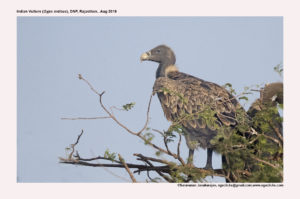Indian Vulture

Indian Vulture (Gyps indicus)
Etymology
- Gyps : Greek word gups – vulture.
- Indicus : From India
Vernacular name : Hindi: Desi Gidh, Pun: Lamchunjhi gidh, Ben: Sakun, Ass: Xagun, Lepcha: Gut, Te: Podugumukku boruva, Guj: Bhukhro gidh, Girnari gidh, Mar: Lamb Chochiche Gidhad, Maha dho
Distribution in India: Widespread across India
Description: Size of 83–91 cm; wt. of 5500–6300 g; wingspan of 196–258 cm. It is a medium-sized vulture with pale body and wing-coverts; blackish neck, with whitish down. The bill is mostly pale yellow; eyes are dark brown; cere is greenish-grey to pinkish-yellow. The juvenile has darker bill, and pale neck is completely covered in whitish down.
Habitat: It inhabits plains and open country near villages, towns and cities, as well as parks and sanctuaries, agricultural areas; usually in company of White-rumped Vulture, but in smaller numbers.
Food Habits: It feeds exclusively on carrion, mostly cattle. It feeds in company of other vultures, especially more numerous White-rumped Vulture, with which it often joins in carrion-feeding guild. The carrion is located by means of keen eyesight; soaring vultures also watch other flying vultures and other scavengers and, when one drops to carcass, all birds in sight follow suit, and many can gather in short time. The Feeding sessions can be raucous at times, with many grunts and hisses as vultures fight over place to feed. It sometimes drinks water flowing off cliff face.
Breeding Habits: They breed in Nov, and young fledge from Mar to May. They typically breed in small to large colonies on cliffs. The nest is a loose platform of sticks, lined with straw; a rather flimsy structure that usually is destroyed by nestling, which pushes sticks off ledge. . They lay a clutch of one egg. The incubation period is 50 days. The adults share nesting duties.